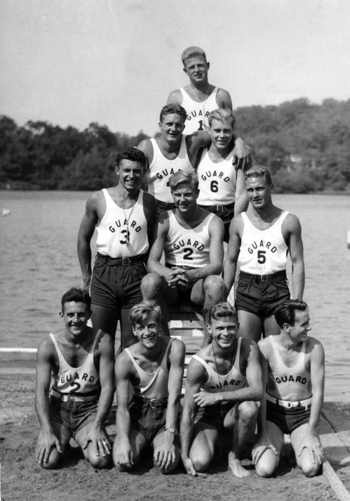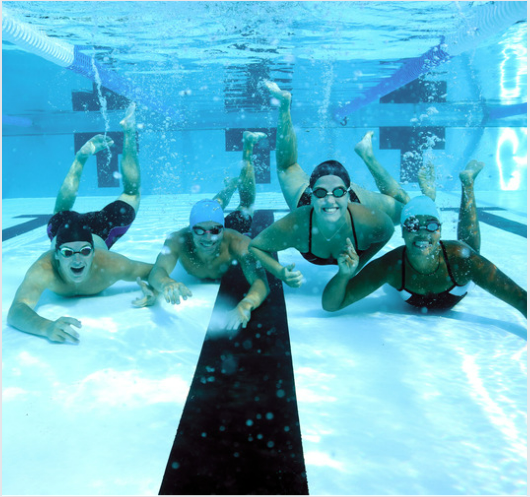Why Do Lifeguards Wear Red?

Chances are if you head to your local pool, you will see arm floaties, lots of sunscreen, and lifeguards in red. Now this is just a guess, but red and yellow are internationally recognized as emergency colors and for as long as most can remember, lifeguards wore red. Long ago, lifeguards used to also wear suits no lifeguard today would want to wear, and the first lifeguards didn’t carry rescue tubes, blow pealess whistles, and weren’t able to perform CPR because it didn’t exist. In modern times, lifeguards are trained extensively and are tasked with performing many skills that doctors in the early 1900’s weren’t able to perform. A lot has changed for lifeguards over the years so why do we still assume that lifeguards wear red?  Well the answer is that more and more, lifeguards aren’t always wearing red. Red is still a common uniform color you’ll see, but as the lifeguard profession and the aquatics industry evolves and grows, there are facilities that are increasingly turning to alternatives. Aquatic facilities are no longer just local shoeboxes in the ground. Lifeguard teams are not just a dozen local kids looking for summer jobs. Waterparks can span as much as 35 or more acres and can support staffs of 250 or more. This is a far cry from a six lane, two lifeguard pool. Aquatic facilities, in addition to their size, may also have their own identity, logos, and mascots. Even local park districts and townships are naming and branding local waterparks to better attract patrons, and theme an experience for their visitors. With the introduction of a customized aquatic facility brands, and unique looks, red uniform pieces may not allow for a cohesive professional uniform. Logos with tropical colors, or park districts that are orange and maroon, may not think that red shorts provide the look they were hoping for. The introduction of navy, orange, and royal have allowed for an option to classic red, and as this trend continues, the evolution of the lifeguard uniform continues to adapt. With the continued pursuit of more and more branding, the use of black lifeguard components has solved many marketing and branding hurdles. It is becoming a more popular color because it allows lifeguards to have a professional and integrated look. Black shorts and black suits can support nearly any combination of branded colors, and will allow the lifeguard to look like an authority, appear rescue ready, and support and promote their brand.
Well the answer is that more and more, lifeguards aren’t always wearing red. Red is still a common uniform color you’ll see, but as the lifeguard profession and the aquatics industry evolves and grows, there are facilities that are increasingly turning to alternatives. Aquatic facilities are no longer just local shoeboxes in the ground. Lifeguard teams are not just a dozen local kids looking for summer jobs. Waterparks can span as much as 35 or more acres and can support staffs of 250 or more. This is a far cry from a six lane, two lifeguard pool. Aquatic facilities, in addition to their size, may also have their own identity, logos, and mascots. Even local park districts and townships are naming and branding local waterparks to better attract patrons, and theme an experience for their visitors. With the introduction of a customized aquatic facility brands, and unique looks, red uniform pieces may not allow for a cohesive professional uniform. Logos with tropical colors, or park districts that are orange and maroon, may not think that red shorts provide the look they were hoping for. The introduction of navy, orange, and royal have allowed for an option to classic red, and as this trend continues, the evolution of the lifeguard uniform continues to adapt. With the continued pursuit of more and more branding, the use of black lifeguard components has solved many marketing and branding hurdles. It is becoming a more popular color because it allows lifeguards to have a professional and integrated look. Black shorts and black suits can support nearly any combination of branded colors, and will allow the lifeguard to look like an authority, appear rescue ready, and support and promote their brand.

It’s hard to believe, but lifeguards have been on hand for over a century. Throughout this time, there have been changes to fashion and styles in society as well. Where in the 1930’s and 40’s red wasn’t a common color for swim attire, you look at a pool or park now and it is bursting with every color under the sun. Lifeguards may have stood out and been easily recognizable back then, but that may not be the case in a lot of environments today. The development of safety yellow for lifeguard uniforms has many advantages over the uniforms seen back then. Safety yellow allows for lifeguards to be seen across large facilities. Not only to be easily identified by visitors, but also for their safety. It is easy to find and determine if a lifeguard has dropped their zone from across the park without any second guessing. In addition, patrons can easily recognize how many lifeguards are up and can rest assured they are in a safe environment. Safety yellow aids in promoting a team environment because lifeguards easily find their closest teammate for support when they need it most. Red is, and will probably always be, the stereotype for what people think lifeguards wear. But as the aquatic industry, and the lifeguard profession, continues to grow and evolve, it is apparent that lifeguards that wear red may not have a place in all aquatic facilities. The introduction of alternative colors such as navy, orange, and royal have only highlighted the need for continued attention towards lifeguard uniforms that support teams in the demanding environments they perform in. Safety yellow for lifeguard uniforms has benefits that support everything from lifeguard safety to guest satisfaction. Red may have been the uniform color of choice, but as the industry and profession move forward, the question is why should lifeguards wear red anymore? Image Sources: Kiefer and Vintage Everyday







Leave a Comment
Your email address will not be published. Required fields are marked *